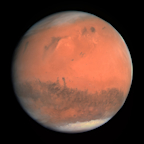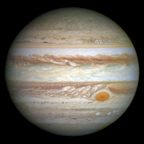Search results
Venus is the second planet from the Sun. It is a terrestrial planet and is the closest in mass and size to its orbital neighbour Earth. Venus is notable for having the densest atmosphere of the terrestrial planets, composed mostly of carbon dioxide with a thick, global sulfuric acid cloud cover.
Venus is the second planet from the Sun, and the sixth largest planet. It’s the hottest planet in our solar system. Venus is a cloud-swaddled planet named for a love goddess, and often called Earth’s twin.
Venus Facts. Venus is the second planet from the Sun and is the second largest terrestrial planet. Venus is sometimes referred to as the Earth’s sister planet due to their similar size and mass. Venus is named after the Roman goddess of love and beauty.
4 days ago · Venus, second planet from the Sun and sixth in the solar system in size and mass. No planet approaches closer to Earth than Venus; at its nearest it is the closest large body to Earth other than the Moon .
Jul 9, 2024 · Venus is the hottest planet in our solar system. Venus is a terrestrial planet. It is small and rocky. Venus has a thick atmosphere. It traps heat and makes Venus very hot. Venus has an active surface, including volcanoes! Venus spins the opposite direction of Earth and most other planets. Time on Venus. A day on Venus lasts 243 Earth days.
The only planet named after a female figure, Venus is a celestial oddball. Though its rocks are shades of grey, its atmosphere imparts an eerie orange glow to the landscape. Together with...
Venus is the second planet from the Sun, and Earth's closest planetary neighbor. It's the hottest planet in our solar system.
155. Venus is the hottest planet in our solar system. This hostile world is covered in thousands of volcanoes and is encased in a dense layer of toxic clouds, swept along by constant hurricane-force winds. Explore facts about the planet closest to Earth.
From Earth, Venus is the brightest object in the night sky after our own Moon. The ancients, therefore, gave it great importance in their cultures, even thinking it was two objects: a morning star and an evening star.
Highlights. Venus may have had oceans and been habitable to life in the past. Today, it is an inhospitable place with searing temperatures and crushing pressure. By studying Venus, scientists learn how Earth-like planets change over time.



















